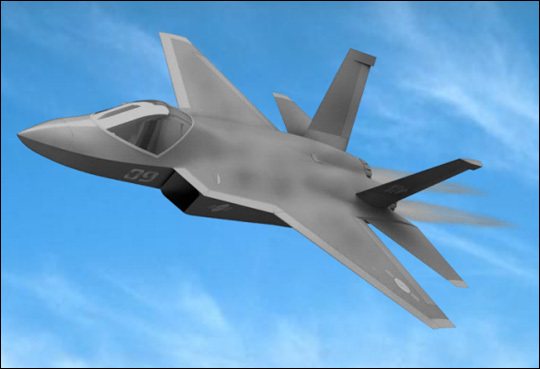Korea Aerospace Industries, the country’s sole aircraft maker, was selected as the preferred bidder for an 8.6 trillion won ($7.8 billion) project to develop an indigenous fighter jet by 2025, Seoul’s military acquisition agency said Monday.
The national defense acquisition program committee, presided over by Defense Minister Han Min-koo, made the decision to speed up the project, codenamed “KF-X,” which has been more than a decade behind schedule due to budgetary and feasibility issues.
The national defense acquisition program committee, presided over by Defense Minister Han Min-koo, made the decision to speed up the project, codenamed “KF-X,” which has been more than a decade behind schedule due to budgetary and feasibility issues.

KAI beat Korean Air in a two-way competition to win the country’s largest-ever acquisition deal under which Seoul plans to develop the KF-16-class warplane to replace aging F-4s and F-5s. Seoul seeks to deploy 120 fighters by 2032. The manufacturing cost ― excluding the development cost ― is estimated around 9.6 trillion won.
“We have evaluated the development plans of the two candidates, their capabilities and development costs, and picked KAI as the preferred bidder,” the Defense Program Acquisition Administration said in a press release.
The DAPA will carry out negotiations with KAI over price and technology-related issues through May, officials said. The national defense acquisition program committee will make a final decision and confirm the winner of the project at its session in June, though KAI will become the winner should there be no serious problems with the firm.
KAI participated in the project with a technological partnership with the U.S. defense firm Lockheed Martin to win the high-profile project. Meanwhile, Korean Air teamed up with Airbus Defense and Space.
From the beginning of the competition, KAI was seen as the most likely winner due to its unrivaled experience in developing military aircraft. KAI has manufactured and exported the T-50 trainer jet and the FA-50 light attack fighter, both of which were developed with technological assistance from Lockheed Martin. It also built the Surion utility helicopter.
After the military officially raised the need for the KF-X project in 2002, state and civilian research institutes conducted feasibility studies seven times. But the project has been delayed due to failures to secure adequate funds. Indonesia joined the project, agreeing to shoulder some 20 percent of the development cost.
KAI expressed confidence in developing the home-built fighter, which will help bolster national defense and increase defense exports.
“We will do our utmost to develop the aircraft, definitely by the deadline, and minimize any aerial security vacuum (that may arise due to a shortage of fighter jets),” KAI said in a press release.
“We will also secure our capabilities to upgrade the aircraft to meet the operational needs in future battlefields. Beyond our contribution to national defense, we will also push to develop the aircraft that is exportable.”
During Monday’s defense acquisition committee session, defense leaders also decided to purchase Patriot Advanced Capability-3 interceptors through a government-to-government “foreign military sale” deal with the U.S. government.
The committee also picked the U.S. firm Raytheon as a contractor to upgrade the radar and launchers of Korea’s current PAC-2 interception unit. Seoul plans to purchase the PAC-3 interceptors and upgrade the PAC-2 system by 2020 with a budget of around 1.6 trillion won.
To counter North Korea’s evolving ballistic missile threats, Seoul has been pushing to upgrade the PAC-2 system with fragmentation-type warheads to the PAC-3 system that employs advanced hit-to-kill technology.
By Song Sang-ho (sshluck@heraldcorp.com)
-
Articles by Korea Herald









![[Today’s K-pop] BTS pop-up event to come to Seoul](http://res.heraldm.com/phpwas/restmb_idxmake.php?idx=644&simg=/content/image/2024/04/17/20240417050734_0.jpg&u=)
![[Graphic News] More Koreans say they plan long-distance trips this year](http://res.heraldm.com/phpwas/restmb_idxmake.php?idx=644&simg=/content/image/2024/04/17/20240417050828_0.gif&u=)






![[KH Explains] Hyundai's full hybrid edge to pay off amid slow transition to pure EVs](http://res.heraldm.com/phpwas/restmb_idxmake.php?idx=652&simg=/content/image/2024/04/18/20240418050645_0.jpg&u=20240419100350)

